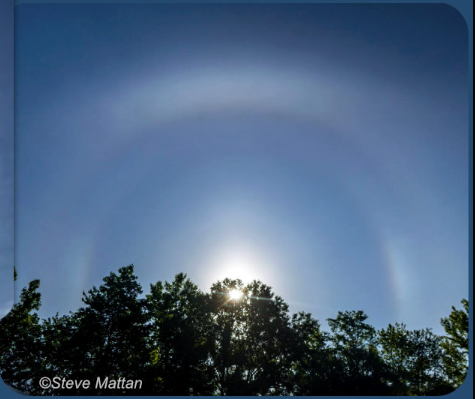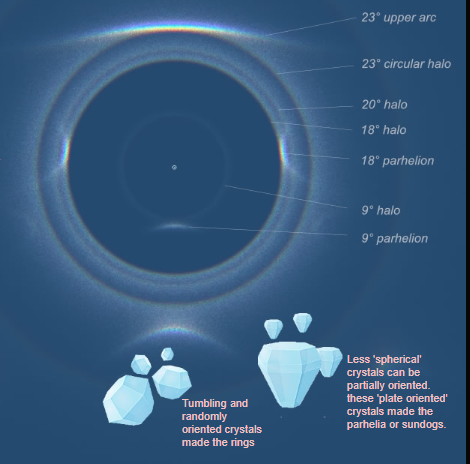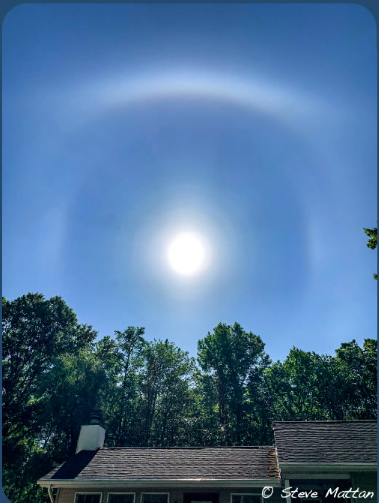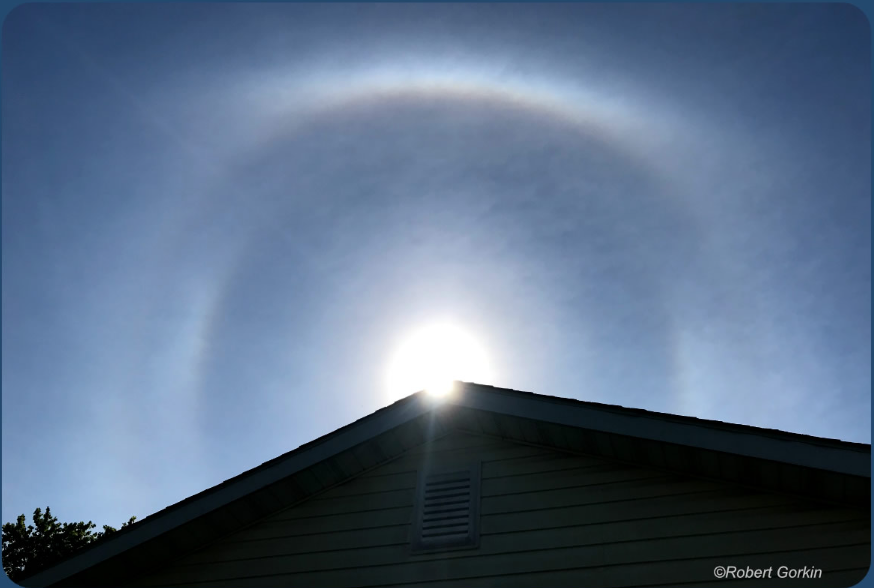Rare pyramidal crystal ice halos across 2 US States
Rare Pyramidal Crystal Ice Halos Across 2 US States
Ice halos are a mesmerizing atmospheric phenomenon that occurs when light interacts with ice crystals suspended in the air. While most halos are formed by hexagonal prism-shaped crystals, there are rare instances where pyramidal crystals create unique and captivating displays in the sky. Recently, two states in the US were fortunate enough to witness these rare pyramidal crystal ice halos, providing a visual spectacle for sky enthusiasts.
The first sighting of these rare ice halos occurred on July 2, 2019, in Delaware, captured by Robert Gorkin. His images revealed the earliest known images of complete Lowitz arcs, which are circular halos formed by pyramidal crystals. Around 80 miles away in New Jersey, Steve Mattan also witnessed the pyramidal crystal halo phenomenon. The vast spread of the pyramidal crystal-containing cirrus cloud encompassed both states, creating a stunning display of atmospheric optics.
Most halos are typically circular due to the aerodynamic and rounded nature of the crystals. However, pyramidal crystals deviate from the ideal shape, resulting in fuzzier and more complex halos. These crystals possess additional pyramids on the prism ends, boasting up to 20 faces and giving rise to a whole new set of halos.
The magic truly unfolds when these less rounded pyramidal crystals become specially oriented. When tilted like plates, they form what is known as "plate displays." In this configuration, they generate extra arcs known as parhelia or pyramidal sundogs. The Delaware-New Jersey halos were indeed a plate display, exhibiting parhelia at least at 18° and 23° angles.
It is worth noting that less spherical crystals can be partially oriented, contributing to the formation of parhelia or sundogs. While the simulation using ideal crystals provides a smarter and sharper representation of these phenomena, the reality observed in nature is often more diverse and captivating.
The Delaware-New Jersey display of pyramidal crystal ice halos showcased a fascinating absence or faintness of the 9° halo. This optical impairment or missing halo could be attributed to the use of crystals with narrow central prism sections, through which the rays of the 9° halo pass. Such deviations from the expected patterns add to the allure and mystery of these atmospheric optics displays.
The simulation also revealed other peculiar parhelia that are rarely seen. Interestingly, predicted CO2 cloud halos on Mars bear a resemblance to these enigmatic parhelia. These unique atmospheric occurrences continue to intrigue scientists and sky enthusiasts alike, offering glimpses into the complex interplay between light and ice crystals.
The tumbling and randomly oriented pyramidal crystals within the cirrus cloud were responsible for the formation of the rings observed in the halo display. As these crystals interacted with sunlight, they scattered and refracted the light, creating a mesmerizing spectacle that captivated onlookers in Delaware and New Jersey.
The sighting of rare pyramidal crystal ice halos across two US states serves as a reminder of the breathtaking beauty and complexity of atmospheric optics. These fleeting moments of wonder continue to inspire scientists and sky watchers to delve deeper into the mysteries of our atmosphere, uncovering new insights into the physics of light and the intricate formations created by ice crystals suspended in the air.


Two-State rare pyramidal crystal halostopticsAHighlightsAtoptics Highlights - Optics Picture of the Day - OPOD - Atmospheric Optics Two views of rare ice halos from pyramidal crystals in high cirrus cloud. Some crystals were unusually well orientated and made strange ‘parhelia’ or sundogs.
At left: Robert Gorkin's sighting from Delaware on July 2, 2019. Robert captured the earliest known images of complete Lowitz arcs.
At right: Steve Mattan's view 80 miles away in New Jersey. The pyramidal crystal containing cirrus spread over a wide area and encompassed two States. Steve's OPOD contributions range from halos to iridescent sea shells, blue flashes and Death Valley mirages (1,2,3,4,5,6,7,8,9).
Most halos come from small cloud crystals shaped as hexagonal prisms. When short they drift within the cloud as horizontal dinner plates. Longer prisms are called columns. Some cloud conditions generate crystals with extra pyramids on the prism ends. Those have up to 20 faces and make a whole set of new halos.
Most pyramidal halos are circular because the crystals are aerodynamically rather rounded and tumble. They are also far from the ideal shapes pictured at right. Their halos are fuzzy as in the 8, 20 and 23° halos of the display.
The fun starts when less rounded crystals become specially oriented. When tilted like plates they form ‘plate displays’ and their extra arcs are parhelia or pyramidal sundogs. The Delaware - New Jersey halos were a plate display with at least 18° and 23° parhelia.

Less 'spherical' crystals can be partially oriented. these 'plate oriented' crystals made the parhelia or sundogs.
At right: A ten million ray HaloSim simulation. It looks smarter and sharper than nature because it used a very limited set of ideal crystals.
The Delaware - New Jersey display had a faint or missing 9° halo. I suppressed it by using crystals with very narrow central prism sections. The 9° halo rays pass through this central section and in the display it must have been missing or optically impaired.
Notice the simulation's other strange parhelia - these are very rarely seen. Predicted CO2 cloud halos on Mars resemble them.
Tumbling and randomly oriented crystals made the rings




Note: this article has been automatically converted from the old site and may not appear as intended. You can find the original article here.
Reference Atmospheric Optics
If you use any of the definitions, information, or data presented on Atmospheric Optics, please copy the link or reference below to properly credit us as the reference source. Thank you!
-
<a href="https://atoptics.co.uk/blog/rare-pyramidal-crystal-ice-halos-across-2-us-states/">Rare pyramidal crystal ice halos across 2 US States</a>
-
"Rare pyramidal crystal ice halos across 2 US States". Atmospheric Optics. Accessed on December 22, 2024. https://atoptics.co.uk/blog/rare-pyramidal-crystal-ice-halos-across-2-us-states/.
-
"Rare pyramidal crystal ice halos across 2 US States". Atmospheric Optics, https://atoptics.co.uk/blog/rare-pyramidal-crystal-ice-halos-across-2-us-states/. Accessed 22 December, 2024
-
Rare pyramidal crystal ice halos across 2 US States. Atmospheric Optics. Retrieved from https://atoptics.co.uk/blog/rare-pyramidal-crystal-ice-halos-across-2-us-states/.